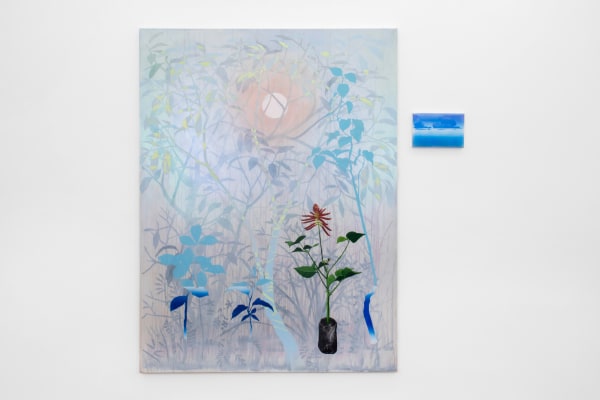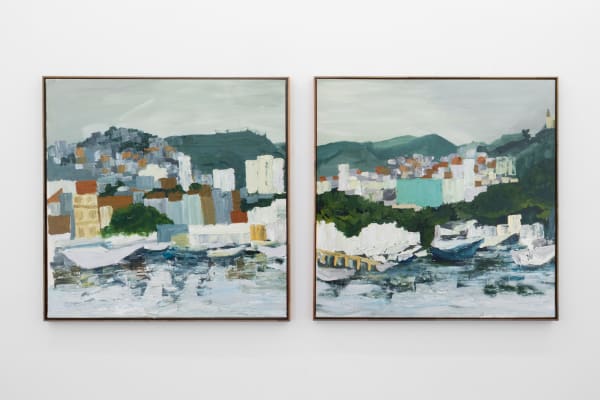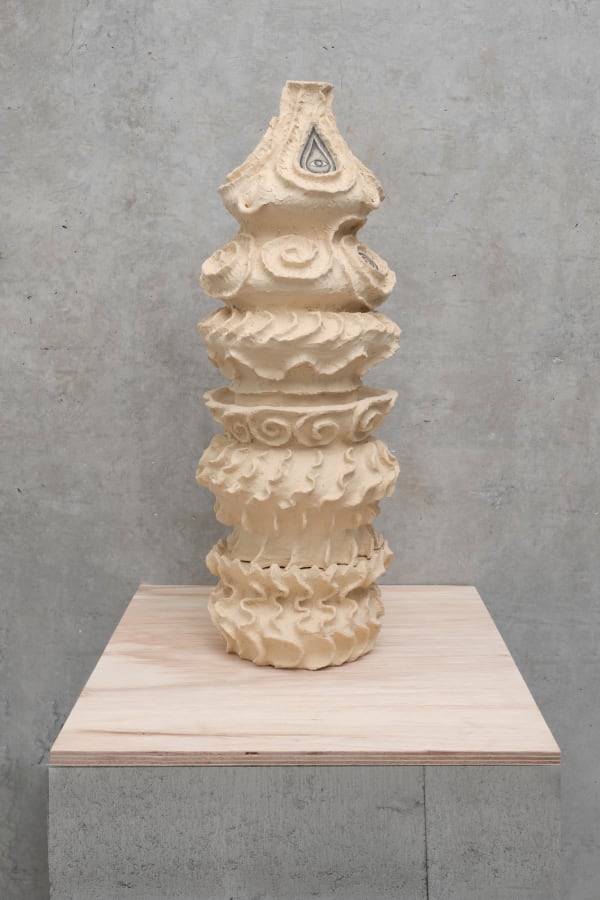Mar, engula-me
A thread of sea colors the horizon
I think the sea has thrown itself upon me and been answered, at least in part, and I believe I am a little changed – not essentially, but changed and transubstantiated as anyone is who has asked a question and been answered.
Hart Crane in a letter to Waldo Frank. April, 1924.
We borrow, as the title of this text, a line from Os Deslimites da Palavra (The Unlimited of the Word) by the Mato Grosso do Sul poet Manoel de Barros, to guide us towards that which has taken over these walls, this floor, and this ceiling, and to look to a bay six hundred kilometers from here, where many of the artistic styles and ideas contained within this space originated, took shape, unfolded in meaning and image, and which derive from the concept of the creature-immensity known, in language, as Ocean.
The paradoxical sweetness that inhabits the idea of dying at sea is also reflected in pieces such as É Bom Morrer no Mar (It’s Sweet To Die At Sea), by Dorival Caymmi, composed together with Jorge Amado during an afternoon spent at Amado’s father's house, and heavily influenced by the Bahian writer’s 1936 novel Mar Morto (Dead Sea). The title of this exhibition, Sea, Swallow Me, derives directly from the 1986 track of the same name by the Scottish band the Cocteau Twins, written in partnership with Harold Budd. It can be found on the album The Moon and The Melodies, in which an ethereal ambiance leads us in search of something undefined, something that seduces us with its mouth, with salt, both soaking us and drying us – and which also speaks, here, of artists who have lost their way at sea, such as Bas Jan Ader, who in his final performance in 1975, took to the ocean in a small boat, or the poet Hart Crane, who jumped from the ship taking him to New York City in 1933, his death recalled by Vinicius de Moraes in his 1953 poem O Poeta Hart Crane Suicida-se no Mar (The Poet Hart Crane Kills Himself At Sea).
Here, we talk of the psychological time/weather that inhabits the ocean, through compositions such as those of Eduardo Baltazar (Rio de Janeiro, 1989), where somber scenes depict a space of privilege for contemplating the desolate yet beautiful possibilities contained within the melancholy of observing an infinite horizon; or in Poeira de Sol (Sun Dust) (2022-2023) by Laura Belém (Belo Horizonte, 1974) and Naufrágio (Shipwreck) (2006), where the artist speaks to us of dusk, that remnant of sand that catches in our eyes and eyelashes at the end of the day, and also of the possibility of disappearance and dissolution that exists in the contact between the human and the hydric.
We also speak of interiority, a movement present here in the constructions of Jonas Arrabal (Cabo Frio, 1984), who takes from the refuse of the ocean itself (such as the shells of oysters and other sea animals, dried coral, lead propellers that simulate a spine) a motif of verticality that corrupts the horizontality characteristic of maritime contemplation, inviting the possibility of diving into the abyss, or the works of Ayla Tavares (Rio de Janeiro, 1990), who, as though in a semantic game, takes clay and transmutes it, speaking to us of water through the process of firing.
The idea of rest and leisure, also often associated with the thin strip of sand that surrounds the ocean, is recreated in this exhibition space in the work of Débora Bolzsoni (Rio de Janeiro, 1975), who, through formal inversion such as that in Margem (Margin) (2009), brings onto the sand a reproduction of that which it contemplates, drawing small waves on piles of sand constructed through play, while at the same time restricting the possibility of rest by confining it to a spatial minimum, as can be seen in the small wooden chair contained within a cube in Leitura na Praia (Reading on the Beach) (2012). E tudo que eu posso te dar é solidão com vista pro mar (And all I can give you is solitude with a sea view), as written by Alvin L. and performed by Marina Lima on her 1991 album, Fullgás. Rio de Janeiro and its scenery becomes, as well as an opportunity, the motif that inhabits the compositions of Renata Leoa (Rio de Janeiro, 1997), informed by an agile, vertical style that intertwines the notions of fauna, flora, and the city in its field of vision, placing us in a watered down in-between that presents and inverts how human action is also capable of attempting to swallow the natural – and the question of whether such action succeeds or not.
And we turn to the natural world as an observer, as in the works of Ruan D`Ornellas (Volta Redonda, 1987), who forces us to confront, through fragments of flora that dilute before a mute sunset, the notion of natural forgetfulness, and of a certain responsibility with the environmental maintenance of memory, or Rodrigo Bivar (Brasília, 1981), who, in the purest presentation of a landscape, speaks of the impassibility of the ocean by presenting us with a rocky fragment, covered in algae, being swallowed up by the voracity of the waves. Entitled Moby Dick, this composition nods to Herman Melville’s great white whale, something that is capable of loving the ocean with such strength, from the depths of its anguish, like someone separated from the creature that, at any moment, could swallow them up.
To talk of the ocean is not an easy task: we, therefore, hope that the body of work in this space will speak to the fever, the sleep, the dreams, and the immensity that inhabits this intrinsic place of memory, violence, thirst and, above all, of the contemplative waiting that seeks to answer an ancestral longing, one that has not yet found its way into our language.
Guilherme Teixeira
![Ruan D'Ornellas Algo entre a lembrança e o desejo (dava pra ver daqui), 2024 Tinta acrílica sobre tela [Acrylic paint on canvas] 200 x 150 cm | 20 x 30 cm [78 3/4 x 59 in | 7 7/8 x 11 3/4 in]](https://artlogic-res.cloudinary.com/w_800,h_800,c_limit,f_auto,fl_lossy,q_auto/artlogicstorage/galeriaathena/images/view/8e5885545ffc5ad45916d9367243244bj/galeriaathena-ruan-d-ornellas-algo-entre-a-lembran-a-e-o-desejo-dava-pra-ver-daqui-2024.jpg)


















